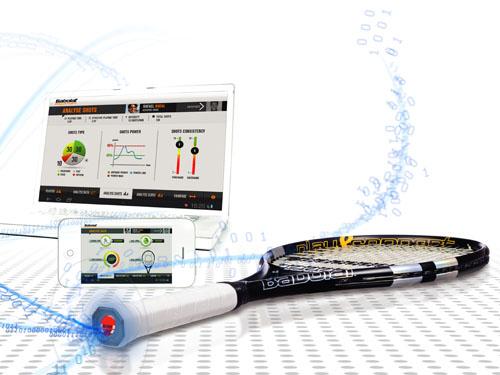MEMS Sensors Bring Intelligence to Tennis Rackets
June 13, 2012

French racket manufacturer Babolat said it will soon roll out a new product that incorporates MEMS (microelectromechanical systems) sensors, enabling users to know how well -- or poorly -- they hit the ball. Known as Babolat Play & Connect, the new racket is expected to reach the market early next year.
"With this technology, you'll know the moment of impact, the impact location, and the position of the racket," Sam Guilaume, CEO of Movea, which created the data fusion systems for the new racket, told us. "It knows how the racket is moving before and after the impact, whether you hit the ball in the center of the racket, and whether you're [imparting] a backspin or forward spin."

Movea has incorporated MEMS-based intelligence on 10 prototype rackets for Babolat. Typically, the new rackets employ two to four MEMS-based sensors in the shaft, along with a small printed circuit board, microcontroller (8 bit or 16 bit), analog-to-digital converter, power management IC, and a Bluetooth transceiver. Because the racket is still months away from production, Movea would not tell Design News what kind of MEMS sensors are being used or who manufactures any of the electronics.
The new racket will employ the MEMS sensors to analyze the impact of the ball striking the racket and the trajectory of the racket, before and after the impact. It will then employ onboard algorithms to analyze the sensor signals, deduce characteristics of the shot, and send its conclusions via Bluetooth wireless to a nearby tablet computer or large screen display.
Guilaume said that Movea has invested "several man-years" of effort into the specifics of the racket's data analysis techniques. The racket's techniques, in turn, are built atop the company's existing SmartMotion data fusion technology, which is the product of more than 350 "man-years" of development and 400-plus patents. Elements of SmartMotion are also employed in set-top boxes, smartphones, and sports equipment.
Pricing of the new smart rackets isn't yet known, but expectations are for it to be about $100 more than conventional high-end tennis rackets, which typically sell for $150 to $200. Babolat's goal is for the new rackets to be purchased by amateur tennis players, as well as pros.
Movea expects the new breed of rackets to be used by players who are serious about their games. Guilaume told us:
You won't use it while you're playing, but after you finish a game, you may want to go back with your coach and do a post-analysis. And you'll be able to know if your forehand is stronger today than it was a week ago.
Related posts:
About the Author(s)
You May Also Like

.jpg?width=300&auto=webp&quality=80&disable=upscale)

